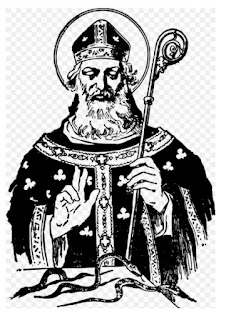St Patrick - father of the Irish church
St Patrick - father of the Irish church
St Patrick's Day, or the Feast of Saint Patrick day is held on 17 March, in commemoration the date of his death (c. 385 – c. 461) He is of course regarded the father of the Irish church
Saint Patrick was a part of the wonderful Christianization of the Celtic religion of the 5th Century - and a poet extraordinaire. He was a key figure in the creation of the early Church. Thanks to the Emperor Constantine the Romans had stopped persecuting Christians in c.313 when he issued the Edict of Milan - which accepted Christianity. Within 10 years it had become the official religion of the entire Roman Empire.
Patrick was
born in 385 (Maewyn Succat) to a wealthy Roman Britannia family in the
modern-day town of Dumbarton, Scotland. His father was a Christian
decurion and so a member of a city senate. St Patrick was therefore not Irish
but from Scotland. He had a Christian background but as is the case of so many
of us his faith was yet fully manifest
At sixteen
he was captured by barbarian Irish pirates and sold into slavery In Ireland. He
was taken 200 miles inland to work as a shepherd for 6 years. Interestingly it
was during this period that his faith came alive. I always think that being a
shepherd would be an Ideal place to develop a religious life. Visions and
Inspiration frequently comes to Shepherds King David (the father of so many
great psalms) was a Shepherd, the Angels at Bethlehem appeared to shepherds,
The Fatima children were shepherds. Although St Patrick was to rise to become a
Bishop his six years as a shepherd will have quietened and opened his mind
During this
time St Patrick had a transformational experience, - a dream or vision which
told him to escape from his captors and leave Ireland. This deepened his faith
and ignited a spiritual fire within him. The vision even showed him an escape
route. Emboldened, Patrick made his break from his captors and travelled back
over 200 miles to the coast. As he approached the docks, a British ship stood
waiting for him. Its sails were unfurled and Patrick was soon home on British
soil - but he didn’t stay long!
Now that he
was back in his homeland he committed to his faith in earnest. He became a
priest and soon felt a he must return to Ireland with a mission! Patrick had no
less of a goal than seeing the whole of pagan Ireland converted! These efforts
did not sit well with Loegaire, the pagan king of pagan Ireland. Patrick faced
danger and even threats on his life. He took to carrying a dagger. Yet, despite
these setbacks, Patrick persisted. Eventually the king was converted and was
baptized by Patrick and so much of the people of Ireland followed suit. Patrick
would come to be known as the “Apostle of Ireland.” He planted churches all
over Ireland, the first one likely at a place called Saul, in Northern Ireland
near Belfast.
The
challenge when recalling Patrick's life separating the facts and the legends. One
such legend was that St Patrick rid Ireland of snakes. Snakes were not in fact
ever native to Ireland. However, the shamrock was. Many biographers claim that
Patrick used the shamrock to teach pagans about the Trinity, that God is one in
essence and three persons, Father, Son, and Holy Spirit.
Legend
further has it that Patrick died on March 17, 461. He likely died in Saul,
where he planted his first church. Curiously St. Patrick is not even truly a
saint because there wasn't a formal canonization process during his life time.
So, we
remember Patrick best not in the legends and fables. Perhaps we remember him
best by reflecting on the “St. Patrick’s Breastplate,” which has traditionally
been attributed to him. The word breastplate is a translation of the Latin
word lorica, a prayer – a prayer especially for protection. These
prayers would be written out and at times placed on shields of soldiers and
knights as they went out to battle.
However,
the true wonder of St Patrick was how immersed he was in his religion. He saw
God in everything he saw. In everything he experienced. God was in his past,
his present and his future. In the people he had met and the people he would
meet.
In short,
saints like St Patrick, they make space for God in their lives. So difficult to
do but so wonderful if we can do it. His poetry stands as a beautiful testimony
to this. Saints like St Patrick lived and breathed this presence and this peace
– and though this changed a nation
In Jesus’s name
Amen
A famous verse from St Patrick’s Breastplate Prayer
Christ with me,
Christ before me,
Christ behind me,
Christ in me,
Christ beneath me,
Christ above me,
Christ on my right,
Christ on my left,
Christ when I lie down,
Christ when I sit down,
Christ when I arise,
Christ in the heart of every man who thinks of me,
Christ in the mouth of everyone who speaks of me,
Christ in every eye that sees me,
Christ in every ear that hears me.




Comments
Post a Comment